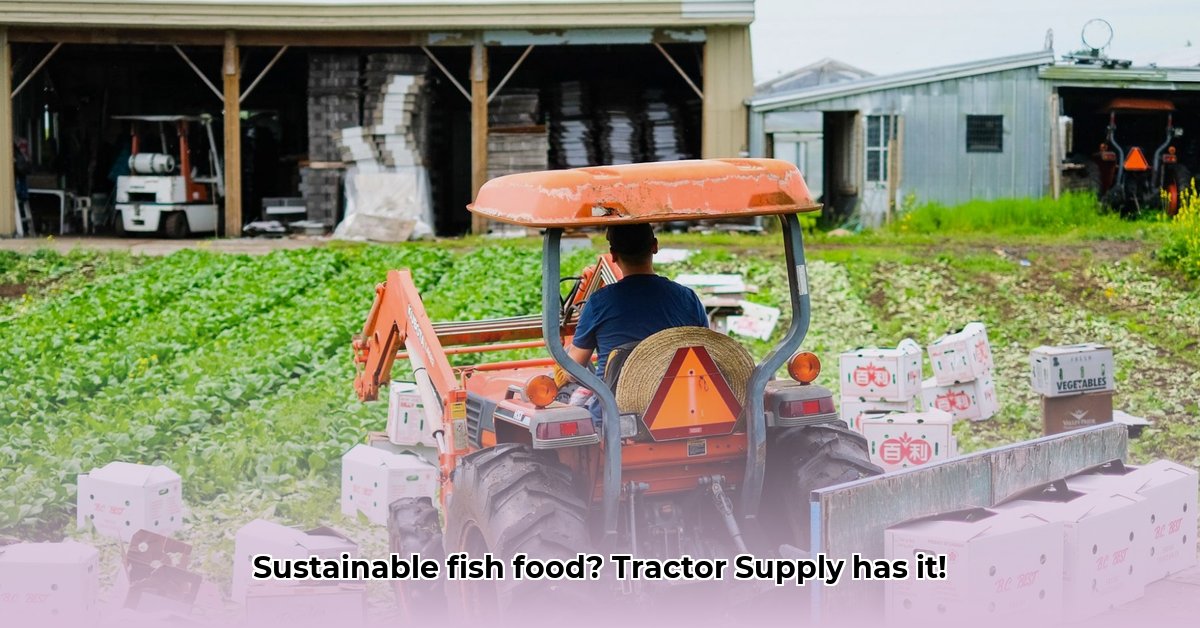
Fish Food at Tractor Supply: Your Guide to Sustainable Choices
Choosing the right fish food is more than just picking the cheapest bag; it's about protecting our oceans and ensuring a healthy future for aquaculture. Did you know the food you give your fish significantly impacts the environment? This guide empowers you to make sustainable choices when shopping for fish food at Tractor Supply. We'll explore the environmental costs of traditional fish food, highlight eco-friendly alternatives, and provide practical steps to help you select the best options for your fish and the planet. For information on other sustainable options at Tractor Supply, check out their deer feeder selection.
The Hidden Environmental Cost of Fish Food
Many conventional fish foods rely heavily on fishmeal—ground-up wild-caught fish. This practice drives overfishing, a serious threat to ocean ecosystems. Overfishing disrupts the delicate balance of marine life, endangering numerous species and potentially impacting long-term ocean health. Is it sustainable to deplete our oceans to feed farmed fish? The answer, clearly, is no.
Sustainable Swaps: Greener Options for Your Fish
Fortunately, sustainable alternatives are emerging, offering a lower environmental impact. These options reduce pressure on our oceans and promote a healthier planet.
Insect-based protein: Insects are highly efficient protein sources, requiring less land and water than traditional livestock farming. While the idea might seem unusual, insect farming has a significantly lower environmental footprint. However, consumer acceptance and potential allergen concerns remain factors.
Plant-based protein: Soy, peas, and other plants are increasingly used in fish food formulations. This is a readily available and ethical choice, but it requires careful formulation to guarantee your fish receives all necessary nutrients.
Single-cell protein (SCP): This cutting-edge approach uses microorganisms like yeast or bacteria, grown in controlled environments. SCP offers high efficiency and scalability potential, but long-term impacts require further research.
Here's a comparison of these sustainable options:
| Feed Type | Pros | Cons |
|---|---|---|
| Insect-based | Highly sustainable, efficient resource use, high protein content. | Some consumers may find it unappealing, potential allergen concerns. |
| Plant-based | Abundant, readily available, generally less expensive, ethically sound. | Might require additional nutrients, varies in nutritional profiles. |
| Single-cell protein | Highly efficient production, potential for large-scale sustainability. | Relatively new technology, potential unknowns regarding long-term effects. |
Your Eco-Friendly Shopping Guide at Tractor Supply
Choosing sustainable fish food at Tractor Supply can be simple. Follow these steps:
Decipher the Label: Look for certifications like the Aquaculture Stewardship Council (ASC) label, signifying sustainable sourcing practices. Carefully review the ingredient list, prioritizing feeds with plant-based or insect-based proteins listed prominently. What percentage of the ingredients are sustainably sourced?
Ask the Experts: Engage with Tractor Supply staff. Inquire about their sourcing practices, sustainability initiatives, and the specific ingredients in different fish foods. Don't hesitate to ask probing questions about their commitment to environmental responsibility.
Compare Products: Take your time comparing various brands and types of fish food. Compare certifications and ingredient lists, prioritizing those with a strong sustainability profile. Remember, the cheapest option isn't always the best choice in the long run. What are the long-term sustainability benefits of the more premium sustainable food options?
Beyond the Feed: A Holistic View of Sustainable Aquaculture
Sustainable aquaculture encompasses more than just the feed. Responsible fish farming practices, such as water conservation, waste reduction, and pollution control, are essential. Supporting these practices makes a broader positive impact on the environment.
What You Can Do Today
Educate Yourself: Learn more about sustainable aquaculture and its broader impact.
Vote with Your Wallet: Support companies committed to sustainable practices.
Spread the Word: Share your knowledge and encourage others to make conscious choices.
Your commitment to sustainability makes a difference. Let's work together to create a healthier environment for our fish and future generations.